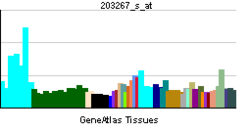DRG2
| DRG2 | |||||||||||||||||
|---|---|---|---|---|---|---|---|---|---|---|---|---|---|---|---|---|---|
| Identifiers | |||||||||||||||||
| Aliases | DRG2 | ||||||||||||||||
| External IDs | MGI: 1342307 HomoloGene: 1061 GeneCards: DRG2 | ||||||||||||||||
| |||||||||||||||||
| RNA expression pattern | |||||||||||||||||
  | |||||||||||||||||
| More reference expression data | |||||||||||||||||
| Orthologs | |||||||||||||||||
| Species | Human | Mouse | |||||||||||||||
| Entrez | |||||||||||||||||
| Ensembl | |||||||||||||||||
| UniProt | |||||||||||||||||
| RefSeq (mRNA) | |||||||||||||||||
| RefSeq (protein) | |||||||||||||||||
| Location (UCSC) | Chr 17: 18.09 – 18.11 Mb | Chr 11: 60.45 – 60.47 Mb | |||||||||||||||
| PubMed search | [1] | [2] | |||||||||||||||
| Wikidata | |||||||||||||||||
| View/Edit Human | View/Edit Mouse |
Developmentally-regulated GTP-binding protein 2 is a protein that in humans is encoded by the DRG2 gene.[3][4][5]
The DRG2 gene encodes the developmentally regulated GTP-binding protein 2, a name derived from the fact that it shares significant similarity to known GTP-binding proteins. DRG2 was identified because it is expressed in normal fibroblasts but not in SV40-transformed fibroblasts. Read-through transcripts containing this gene and a downstream gene have been identified, but they are not thought to encode a fusion protein. This gene is located within the Smith-Magenis syndrome region on chromosome 17.[5]
References
- ↑ "Human PubMed Reference:".
- ↑ "Mouse PubMed Reference:".
- ↑ Schenker T, Trueb B (Jun 1998). "Assignment of the gene for a developmentally regulated GTP-binding protein (DRG2) to human chromosome bands 17p13→p12 by in situ hybridization". Cytogenet Cell Genet. 79 (3–4): 274–5. doi:10.1159/000134741. PMID 9605870.
- ↑ Schenker T, Lach C, Kessler B, Calderara S, Trueb B (Nov 1994). "A novel GTP-binding protein which is selectively repressed in SV40 transformed fibroblasts". J Biol Chem. 269 (41): 25447–53. PMID 7929244.
- 1 2 "Entrez Gene: DRG2 developmentally regulated GTP binding protein 2".
Further reading
- Sprang SR (1998). "G proteins, effectors and GAPs: structure and mechanism". Curr. Opin. Struct. Biol. 7 (6): 849–56. doi:10.1016/S0959-440X(97)80157-1. PMID 9434906.
- Liang Y, Wang A, Belyantseva IA, et al. (2000). "Characterization of the human and mouse unconventional myosin XV genes responsible for hereditary deafness DFNB3 and shaker 2". Genomics. 61 (3): 243–58. doi:10.1006/geno.1999.5976. PMID 10552926.
- Li B, Trueb B (2000). "DRG represents a family of two closely related GTP-binding proteins". Biochim. Biophys. Acta. 1491 (1–3): 196–204. doi:10.1016/s0167-4781(00)00025-7. PMID 10760581.
- Vlangos CN, Das P, Patel PI, Elsea SH (2000). "Assignment of developmentally regulated GTP-binding protein (DRG2) to human chromosome band 17p11.2 with somatic cell hybrids and localization to the Smith-Magenis syndrome critical interval". Cytogenet. Cell Genet. 88 (3–4): 283–5. doi:10.1159/000015539. PMID 10828610.
- Bi W, Yan J, Stankiewicz P, et al. (2002). "Genes in a Refined Smith-Magenis Syndrome Critical Deletion Interval on Chromosome 17p11.2 and the Syntenic Region of the Mouse". Genome Res. 12 (5): 713–28. doi:10.1101/gr.73702. PMC 186594
 . PMID 11997338.
. PMID 11997338. - Strausberg RL, Feingold EA, Grouse LH, et al. (2003). "Generation and initial analysis of more than 15,000 full-length human and mouse cDNA sequences". Proc. Natl. Acad. Sci. U.S.A. 99 (26): 16899–903. doi:10.1073/pnas.242603899. PMC 139241
 . PMID 12477932.
. PMID 12477932. - Song H, Kim SI, Ko MS, et al. (2005). "Overexpression of DRG2 increases G2/M phase cells and decreases sensitivity to nocodazole-induced apoptosis". J. Biochem. 135 (3): 331–5. doi:10.1093/jb/mvh040. PMID 15113831.
- Gerhard DS, Wagner L, Feingold EA, et al. (2004). "The Status, Quality, and Expansion of the NIH Full-Length cDNA Project: The Mammalian Gene Collection (MGC)". Genome Res. 14 (10B): 2121–7. doi:10.1101/gr.2596504. PMC 528928
 . PMID 15489334.
. PMID 15489334. - Rual JF, Venkatesan K, Hao T, et al. (2005). "Towards a proteome-scale map of the human protein-protein interaction network". Nature. 437 (7062): 1173–8. doi:10.1038/nature04209. PMID 16189514.
This article is issued from Wikipedia - version of the 6/6/2016. The text is available under the Creative Commons Attribution/Share Alike but additional terms may apply for the media files.